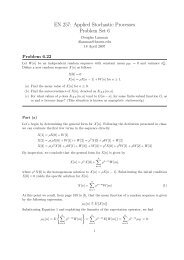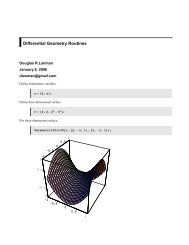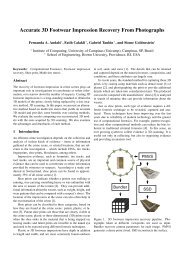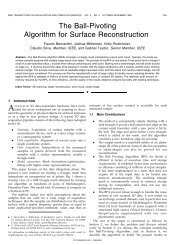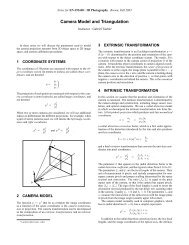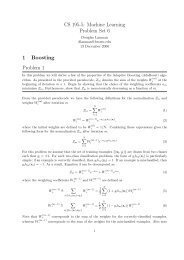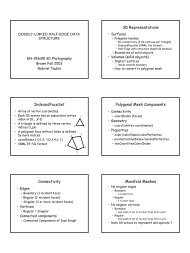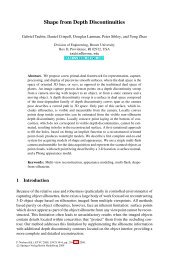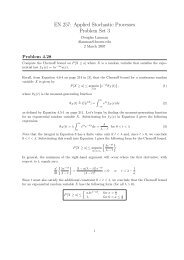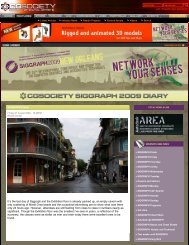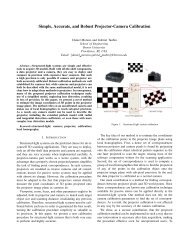Volume Warping for Adaptive Isosurface Extraction - ResearchGate
Volume Warping for Adaptive Isosurface Extraction - ResearchGate
Volume Warping for Adaptive Isosurface Extraction - ResearchGate
Create successful ePaper yourself
Turn your PDF publications into a flip-book with our unique Google optimized e-Paper software.
of the significant details. Finally, we show examples of adaptivetessellations in the third row of both figures.We give in the table below the number of extracted vertices obtainedwith our implementation <strong>for</strong> different volume dimensions.We use isolevels 42, 35, 50 <strong>for</strong> the Bonsai, Skull and Foot dataset,respectively (the volumes are encoded using two bytes per intensity.)Model Original Warped½¾ ¿ ½¾ ¿ ½¼¿ ¿ ¿ ¿ ¿¾ ¿Bonsai 69’811 157’337 77’909 67’676 30’373 5’748Skull 186’009 313’840 162’762 143’661 64’480 12’801Foot 125’052 175’890 77’340 67’820 30’545 6’193Table 1: Number of vertices extracted from the unoptimized andwarped datasets with our implementation.We show in Figure 6 that details are longer preserved in a warpedvolume compared to an unoptimized one when reducing the sizeof the datasets. In the figure, the isosurfaces in the first row areextracted from the (unoptimized) Skull dataset, where the secondrow contains the ones extracted from a warped dataset. The datasetis warped using the importance map shown in Figure 8. The numberof extracted vertices in each case is given in the table below.½¾ ¿ ¿ ¿ ¿¾ ¿Unoptimized 186’009 68’510 29’647 4’669Warped 313’840 143’661 64’480 12’801Table 2: Number of vertices extracted from the reduced unoptimizedand warped datasets.5 Conclusion6 AcknowledgementsWe would like to thank Gregory Abram <strong>for</strong> his assistance withOpenDX. The volume warping pipeline was implemented entirelyin OpenDX and was used to generate the isosurfaces shown in thispaper.References[4] Alan D. Kalvin. Segmentation and surface-based modelingof objects in 3-D biomedical images. Ph.d. thesis, New YorkUniversity, 1991.[5] Leif P. Kobbelt, Mario Botsch, Ulrich Schwanecke, and Hans-Peter Seidel. Feature-sensitive surface extraction from volumedata. In SIGGRAPH 2001, Computer Graphics Proceedings,Annual Conference Series, pages 57–66. ACM Press /ACM SIGGRAPH, August 2001. ISBN 1-58113-292-1.[6] William Lorenson and Harvey Cline. Marching cubes: Ahigh resolution 3d surface construction algorithm. ComputerGraphics, 21(4):163–169, July 1987.[7] Ralf Neubauer, Mario Ohlberger, Martin Rumpf, and RalphSchwörer. Visualization in Scientific Computing ’97, chapterEfficient visualization of large-scale data on hierarchicalmeshes. Springer, Wien, 1997. ISBN 3-211-83049-9.[8] Mario Ohlberger and Martin Rumpf. Hierarchical and adaptivevisualization on nested grids. Computing, 59(4):365–385,1997.[9] Dietmar Saupe and Jens-Peer Kuska. Compression of isosurfaces<strong>for</strong> structured volumes. In Vision, Modelling and Visualization2001, Stuttgart, Germany, November 2001. IEEE.[10] Dietmar Saupe and Jürgen Toelke. Optimal memory constrainedisosurface extraction. In Vision, Modelling and Visualization2001, Stuttgart, Germany, November 2001. IEEE.[11] Raj Shekhar, Elias Fayyad, Roni Yagel, and J. Fredrick Cornhill.Octree-based decimation of marching cubes surfaces.In Visualization 1996, pages 335–344. IEEE, October 1996.ISBN 0-89791-864-9.[12] Francisco Velasco and Juan Carlos Torres. Cells octree: a newdata structure <strong>for</strong> volume modeling and visualization. In Vision,Modelling and Visualization 2001, Stuttgart, Germany,November 2001. IEEE.[13] Ruediger Westermann. A multiresolution framework <strong>for</strong> volumerendering. In Arie Kaufman and Wolfgang Krueger, editors,1994 Symposium on <strong>Volume</strong> Visualization, pages 51–58,1994.[14] Jane Wilhelms and Allen Van Gelder. Octrees <strong>for</strong> fasterisosurface generation. ACM Transactions on Graphics,11(3):201–227, July 1992. ISSN 0730-0301.[15] Z. J. Wood, M. Desbrun, P. Schröder, and David Breen. Semiregularmesh extraction from volumes. In Visualization 2000,pages 275–282. IEEE, October 2000. ISBN 0-7803-6478-3.[1] Chandrajit Bajaj, Insung Ihm, and Sanghun Park.Visualization-specific compression of large volume data.In Proceedings of Pacific Graphics 2001, pages 212–222,Tokyo, Japan, October 2001.[2] Laurent Balmelli, Gabriel Taubin, and Fausto Bernardini.Space-optimized texture maps. To appear in Proceedingsof Eurographics, September 2002. preprint available athttp://www.balmelli.net/download/RC22328.pdf.[3] Paolo Cignoni, Paola Marino, Claudio Montani, EnricoPuppo, and Roberto Scopigno. Speeding up isosurface extractionusing interval trees. Transactions on Visualization andComputer Graphics, 3(2):158–170, April - June 1997. ISSN1077-2626.




